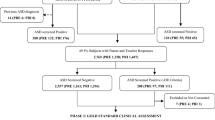Abstract
The prevalence rate of autism has been reported as 0.04% to 0.05%, but one recent study in Japan found prevalence of 0.16%. The authors have been involved in routine well-child medical examinations at 18 months of age, at the Midori Public Health Center in Nagoya. A statistical survey of diagnoses was made from April 1979 to March 1984 for the purpose of conducting an epidemiological study of autism. Of 12,263 children examined, 168 were identified as having developmental problems and, of these, 139 underwent a second examination. Autism was diagnosed in 16 of these children and a category called “autism suspected” was defined in an additional 10 of these 139 children. The 16 cases of autism gave a minimum prevalance of 0.13%, three times the usually reported rate. The validity of the higher prevalence rates is discussed.
Similar content being viewed by others
References
American Psychiatric Association. (1980).Diagnostic and statistical manual of mental disorders (3rd ed.). Washington, DC: Author.
Bohman, M., Bohman, I. L., Björck, P. O., & Sjöholm, E. (1983). Childhood psychosis in a northern Swedish county: Some preliminary findings from an epidemiological survey. In: H. Schmidt & H. Remschmidt (Eds.),Epidemiological approaches in child psychiatry II: International symposium Mannheim 1981 (pp. 164–173). New York: Thieme-Stratton.
Delong, G. R., Bean, S. C., & Brown, F. R. (1981). Acquired reversible autistic syndrome in acute encephalopathic illness in children.Archives of Neurology, 28, 191–194.
Gillberg, C. (1986). Onset at age 14 of a typical autistic syndrome. A case report of a girl with Herpes Simplex encephalitis.Journal of Autism and Developmental Disorders, 16, 369–375.
Hoshino, Y., Yashima, K., Ishige, K., Tachibana, R., Watanabe, M., Kaneko, M., Kumashiro, H., Ueno, B., Takahashi, E., & Furukawa, H. (1980). An epidemiological study of autistic children in Fukushima-ken.Japanese Journal of Child and Adolescence Psychiatry, 21, 111–128.
Ishii, T., & Takahashi, O. (1983). The epidemiology of autistic children in Toyota, Japan: Prevalence.Japanese Journal of Child and Adolescence Psychiatry, 24, 311–321.
Kanner, L. (1957).Child psychiatry (3rd ed.). Springfield, IL: Charles C Thomas.
Lotter, V. (1966). Epidemiology of autistic condition in young children. I. Prevalence.Social Psychiatry, 1, 124–137.
Ornitz, E. M., Guthrie, D., & Farley, A. M. (1978). The early symptoms of childhood autism. In G. Serban (Ed.),Cognitive defects in the development of mental illness (pp. 24–42) New York: Bruner/Mazel.
Rumsey, J. M., Rapoport, J. L., & Sceery, W. R. (1985). Autistic children as adults: Psychiatric, social and behavioral outcomes.Journal of the American Academy of Child Psychiatry, 24, 465–473.
Sugiyama, T., Saburi, M., Iwatsuki, Y., Tsuda, Y., Takashima, M., Yamagishi, T., Tsukata, T., Komada, T., Hasegawa, K., & Tatematsu, F. (1980). The results and problems of the health check-up for one and a half olds.Psychiatria et Neurologia Paediatrica Japonica, 20, 61–70.
Treffert, D. A. (1970). Epidemiology of infantile autism.Archives of General Psychiatry, 22, 431–438.
Wing, L., & Gould, J. (1979). Severe impairments of social interaction and associated abnormalities in children: Epidemiology and classification.Journal of Autism and Developmental Disorders, 9, 11–29.
Wing, L., Yeates, S. R., Brierley, L. M., & Gould, J. (1976). The prevalence of early childhood autism: Comparison of administrative and epidemiological studies.Psychological Medicine, 6, 89–100.
Yamazaki, K., Yamashita, I., Suwa, N., Kuroda, T., Iwabuchi, J., Imamura, S., Miyamoto, M., Fujino, T., Ito, N., & Sugaya, K. (1971). Survey on the morbidity rate of “autistic children” in the Hokkaido district.Japanese Journal of Child and Adolescence Psychiatry, 12, 141–149.
Author information
Authors and Affiliations
Rights and permissions
About this article
Cite this article
Sugiyama, T., Abe, T. The prevalence of autism in Nagoya, Japan: A total population study. J Autism Dev Disord 19, 87–96 (1989). https://doi.org/10.1007/BF02212720
Issue Date:
DOI: https://doi.org/10.1007/BF02212720




